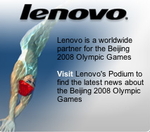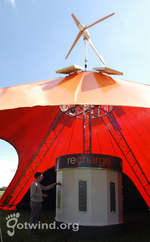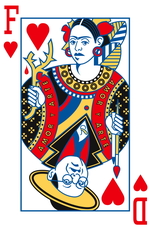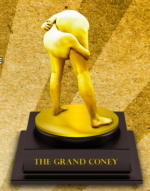Postopolis, the Los Angeles edition
Posted in: Uncategorized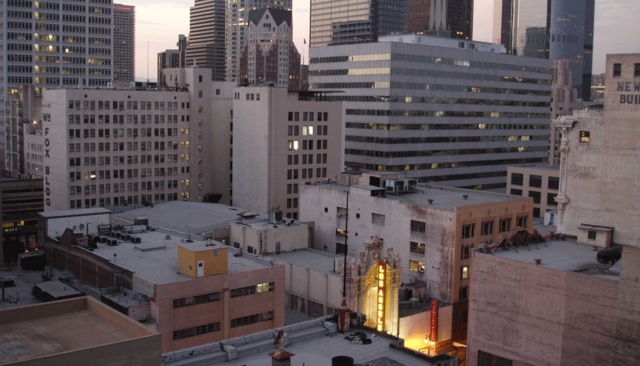
A quick interview with Vernissage TV
Posted in: Uncategorized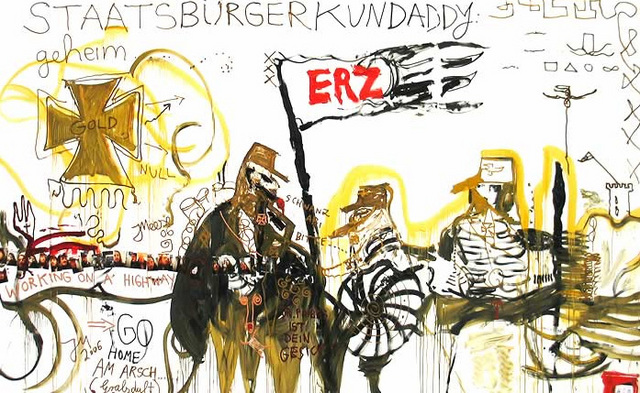
Architecture, urbanism and technologies in the conflict Palestina/Israel – I need your suggestions
Posted in: UncategorizedAt the end of next week, i’m going to be at the University of Architecture in Alicante for a workshop headed by Jose Perez de Lama and Pablo de Soto from hackitectura. I’m particularly glad to be working with them as i’ve been admiring their work for a few years now (cf. one of their previous works, Situation Room.)
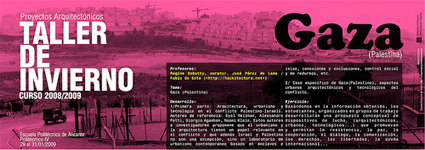
The title of the workshop is Gaza (Palestina). Architecture, urbanism and technologies in the conflict Palestina/Israel. The objective of this (complex and how so delicate) event is to study the conflict and the role architecture and urbanism have in its development, but also to explore how a kind of laboratory of contemporary urbanism has emerged from the situation: gated communities, social controls, isolated islands, connections and disconnections, exclusion, alienations, etc.
Pablo has spent the past few weeks in Egypt where he is creating an alternative cartography of the frontier between Egypt and Gaza, more precisely in Rafah. We are collecting videos, information, links, online essays, artistic experiences, etc. Anything that could help us get a better picture of the issue and trigger ideas in the brain of the smart little students who would have to come up with proposals that foster and allow dialog, resistance, peace, human rights, communication, freedom, mutual understanding, international help, etc. That’s where i’m asking you if you have any suggestion of information we could use. You could either add them to my del.icio.us links by tagging the links with for:regine, add comments on this post or write me to the usual address (see second column on the homepage).
I’m going to document all our findings as well as the development of the workshop on a separate blog. Will update this post with a link to it next week.
Ogilvy — er, Lenovo — Blogs and Tweets the Summer Olympics
Posted in: UncategorizedOrange Brings Wind Power to Phones of Glastonbury Revelers
Posted in: UncategorizedA-B Ditches Energy Bevs, Sleepers Solicited, IDA Seeks Airwave Rejects
Posted in: UncategorizedFrida Kahlo and Diego Rivera Meet (and Match) Again
Posted in: UncategorizedDitch Cannes for Coney! Here Are 8 Reasons Why
Posted in: UncategorizedBoston’s Twitterati Geek Out With Gary Vaynerchuck At Live Thunder Show
Posted in: UncategorizedHeartburn Drug Sponsors Racing Sweepstakes! And There is Absolutely Nothing Wrong with That!
Posted in: UncategorizedSightseeing telescope reveals open wifi networks in urban space
Posted in: UncategorizedI’m back from Asturias which was as lovely as ever. We even had real vegetable to eat this time. The LAboral Art and Industrial Creation Centre in Gijón was opening Banquete_nodos y redes, Interactions Between Art, Science, Technology and Society in Spain’s Digital Culture, an exhibition initiated by Karin Ohlenschläger and Luis Rico.
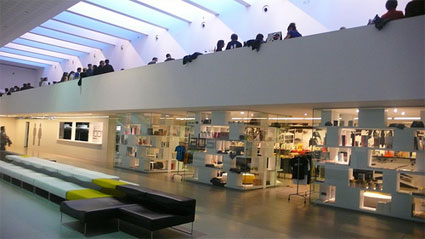
View of the LABoral shop and of the inauguration party right above it
The press conference started with a string of surprising figures listed by LABoral’s Director Rosina Gómez-Baeza Tinturé. In its 14 months of activity, the centre -which has given itself the mission to foster the interaction between art, society and technology- has hosted the work of 261 creators (45 of them come from the region of Asturias), 54 workshops given by some 90 teachers to more than 3000 participants. Add to that many concerts, conferences, debates and other activities. Amazing, even for a space that covers more than 14.000 m². Which reminds me that it would be good to come back one day on the design and architecture of the centre. The public bathrooms only are worth the visit, i feel like stepping inside 2001: A Space Odyssey each time i enter there.
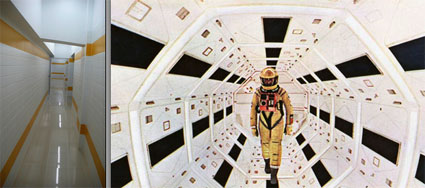
LABoral bathroom and a scene from 2001: A Space Odyssey
Banquete_nodos y redes presents more than 30 digital and interactive works that critically and creatively explore the notion of Network as a shared matrix, not just from a technological perspective but also from a socio-cultural perspective. I’ll be back with a lengthier overview of the exhibition and a small interview with its curator, the art critic Karin Ohlenschläger, later on but right now i wanted to share with you one of the best projects i saw in Gijón last week.
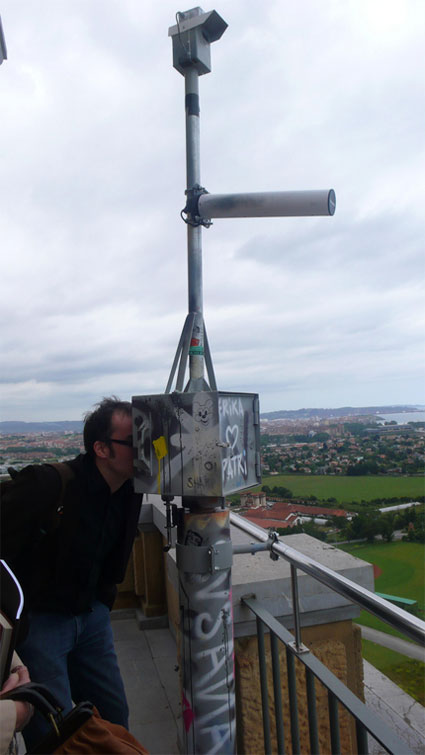
You’ve probably read about Clara Boj and Diego Diaz before, either in some media art catalog or on this blog, i interviewed them a few months ago about their project AR Magic System, their Lalalab studio and their interest for the visualization of wifi networks.
For the LABoral exhibition, the Valencia-based duo developed a sightseeing telescope named Observatorio (Observatory).
Observatorio builds upon Boj and DIaz’ 2004 project Red Libre Red Visible (Free Network, Visible Network) which was born in an optimistic time when it seemed possible to achieve an utopia made of wireless, open communication networks managed by social groups offering services to the local community. At that (not so distant) time, several city governments offered free access to the WiFi network, sometimes in the entire city. The CMT (Telecommunications Market Commission) denounced those city governments for unfair competition with telecom companies, the free wifi municipal projects were canceled, and grassroot groups started installing, maintaining and extending open WiFi networks throughout Spain.
Today, some companies have adopted new tactics based on the deceptive slogan “Share your WiFi”. Companies like FON, and commercial projects such as Whisher and Wefi exploit the current infrastructure of access nodes to the Internet in urban space to provide coverage to the whole city if it were an open, shared structure.
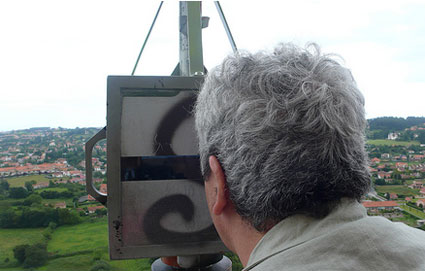
Obervatorio reflects on this scenario by informing viewers about the current state of wireless networks located in the area where the device is installed. The sightseeing telescope, installed on the Laboral tower, tracks and shows where Gijon’s wifi networks are located in real time. You can visualize them on the screen of the telescope, swing it around and see which areas have a denser wifi coverage, and get additional data such as which ones among these networks are open or private. Because Observatorio is programmed to try and connect to any open network available in the area, it can send the information from the observation tower to the exhibition hall, where it is displayed on a big screen. If there is no open networks detected in the area, Observatorio remains separated from the main exhibition space, located in another building. A modification of these networks is also offered, showing an ideal configuration in which the local residents of large areas in the city could gain or share access to it.

Image courtesy LABoral Centro de Arte y Creación Industrial
After having installed Observatorio, the artists discovered many more open nodes than they expected. While testing the project at their studio in Valencia, they couldn’t find more than 5% of open networks. In Gijón the percentage is higher, around 30% in the LABoral area.
From the tower Observatorio can reach theoretically almost the whole city of Gijón. The device comprises a high power uni-directional WiFi antenna with a 30º aperture, able to detect wireless networks within 1 to 4 kilometers depending on the number of obstacles encountered; a video surveillance camera with a telephoto lens with the same aperture as the WiFi antenna; and a viewer which, like a periscope, offers a real time image taken by the camera, with the WiFi networks detected by the antenna placed geographically on it.
Banquete_nodos y redes runs at LAboral Art and Industrial Creation Centre in Gijón, Spain, until November, 03, 2008. The exhibition will then travel to the ZKM | Center for Art and Media in Kartlruhe, March-July 2009.
More sightseeing telescope: The timetravel telescope, the Jurascope and the Elastic time and space telescope.
Also related: Wifi Camera Obscura.
CNBC-Created FedEx Spoof Ad Craps on UPS’ Big Brown Belmont Loss
Posted in: UncategorizedGet a Trashbag and Some Lipgloss. You’re Going to a Recycling Party!
Posted in: Uncategorized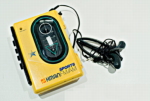
Hungry Man TV is throwing an RSVP-only party for Internet Week, NY.
Videos of the day: The Influencers
Posted in: UncategorizedThe Influencers is a Barcelona-based event which explores controversial forms of art and communication guerrilla, presenting independent projects that play with global popular culture, infiltrate the mass media, and transform fashions, consumption and technological fetishism.
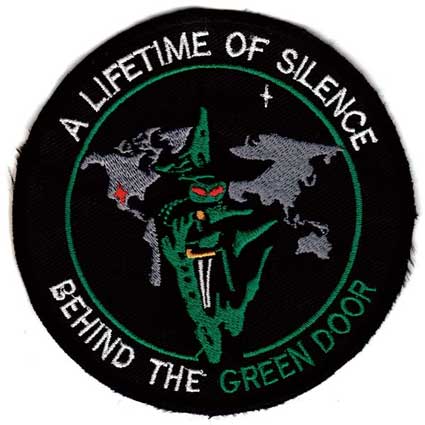
One of Paglen’s patches
It was one of the very few conferences i shouldn’t have missed this year. Well… i did. But life has its little consolations and the videos of The Influencers have just found their way online. Most of them at least, the missing ones will be there in the next few days. In the meantime, hurray! There is Trevor Paglen (video) and Brody Condon (video). There’s also wondrous Santiago Cirugeda (video), he speaks in spanish and one day, maybe one day, i will translate his talk and publish the text here.
Wrath of Cannes Lives to See its Second Year
Posted in: UncategorizedSony’s House Design of the Future
Posted in: UncategorizedThere are a lot of things left unanswered as far as our future is concerned and a lot of it has to do with where we will find ourselves in the course of time. One thing we have to note is that global warming and eco-friendly issues will be beside us all the way and with that in mind, we cannot help but think what companies such as Sony will have for us by that time.
Sony can help us get a glimpse of things to come and they are showing this to us with this video that gives us highlights of the future. Take a look at this video so that you will have an idea on whether to look forward to the future or simply keep on wondering what we have in a couple of years ahead of us.
Technorati Tags: sony, technology, highlights, future, advertising, video, eco-friendly, global warming
In New York
Posted in: UncategorizedFirst of all a little present. I’ve got one free pass for a reader interested in attending Mediabistro Circus which takes place in New York on May 20 and 21. The two-day conference focuses on the digital platforms and trends that are changing media today. Just send me an email (reg at this domain’s address) explaining why you’d like to go and i’ll forward the details of the most charming/desperate/convincing reader to the organizers of the event.
An overview of the programme: May 20: the publishing industry’s transition to new media, successful business models, blog power and finally video and social media. May 21: mobile media, the editor of digital news for the New York Times discussing the passage to online publication and user experience design (believe it or not i’m taking part to that panel!)
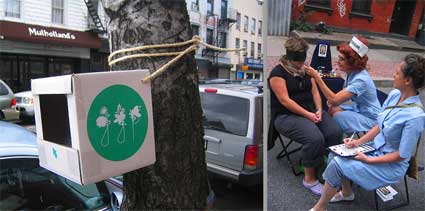
Scenes from the 2007 edition of Conflux
Next! One of my favourite events on this planet is Conflux, the festival of psychogeography which gathers artists, technologists, psychogeographers, urban explorers and experience designers from around the world in New York every year.
The organizers have recently opened their call for project. Deadline for submission is May 31.
Diseño Emergente 2.0
Posted in: UncategorizedFirst off I’d like to apologize for the size of the image, but I think in this case it’s worth it.
A little over two years ago, a small group of chilean design students decided to generate an online space that allowed design students from all its branches and schools to share their projects and create contact and collaboration networks that led to improve and enhance the national design scene. That website was Diseño Emergente (Emerging Design).
Now, with an insanely powerful base of monthly visitors and projects, Diseño Emergente is, without a doubt, the space where chilean (and slowly more latinamerican) design students converge and share, debate and display their ideas.
By chance of life, I had the pleasure of being one of the first few members of this community and for a while I was part of their staff, with whom to this day I keep a very close relationship.
This is why seeing progress like the one I’ll refer to is trully a reason for pride and satisfaction, knowing that in Chile there are people who dare to take the plunge, to go against the odds, and do it right, with love for what they do and the seriousness and responsability it deserves.
The reason for this slightly long post is to tell you about the release of Diseño Emergente 2.0,. A total review of the website’s interface and functions was made directly from the input of its own users and not just what the staff thought was right.
Even if you’re not a spanish-speaking person, I encourgae you to take a look at the portfolios section, I’m sure you’ll find a few things that’ll blow your mind.
For someone like me, who’s passionate about design, programming and interaction, this website really is a luxury. A whole bunch of new features that speed up your reading time, enhance relationships between users and also enhance the participation of 3rd party users from chilean student design.
So I’m just leaving the invitation open for you to check out the all new Diseño Emergente, ’cause even with its many haters, it’s impossible to deny its real cultural and design weight in chilean society.
My biggest congratulations, and deepest respect to the staff that daily tries to take chilean design to the next level. People like these are the ones that count.
Political Advertising Vie for Air Time Slots
Posted in: Uncategorized
If there is one thing that will really help you get our political aspirations towards better heights, television advertising is a best bet to get the job done. Not all people can afford television advertising due to the cost of having one. Secondly, it is not merely a matter of producing the ad itself. It also includes being able to get the desired time slot that will surely be hitting the proper voters who will know that you are running for public office.
Such is an issue that many call as dirty but advantageous. But if you have the funds to support your ad campaign and likewise avoiding any potential discrepancies on election requirements, then by all means use advertising to boost your political campaign!
Federal rules requiring candidates to have access to similar television audiences forced stations to bump some advertising from their traditional clients. In some cases, it was purchased months in advance and in a highly sought-after spot.
(Source) Business Weekly
Technorati Tags: television, political, voters, advertising, campaign






